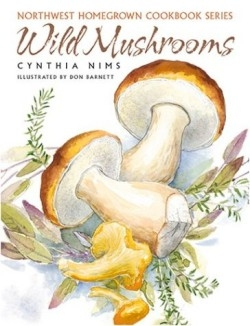Wild Mushrooms
“A big pet peeve of mine,” writes the author, “is misuse of the term ‘wild mushrooms.’ It’s disappointing to order a wild mushroom risotto only to find the creamy-delicious rice speckled not with chanterelles, hedgehogs, or morels, but with shiitakes, crimini, or portobello.” With that snippet from the brief essay “When ‘Wild’ Mushrooms Aren’t,” the reader learns a couple of things. The first is that the general population is not as educated as they could be on mushrooms, facilitating the bait-and-switch game. The second is that, with the ability to discern a mushroom variety from chopped bits cloaked in cream, Nims is no wild mushroom ninny.
With beautiful watercolor illustrations and personal essays interspersed through the forty recipes, this book is good enough to take to bed, or at least let lounge on the coffee table. This third volume of the Northwest Homegrown Cookbook Series (preceded by Crabs and Stone Fruit) continues the series’ goal of showcasing the regional foods of the Northwest. With its moist climate, the region appears to be wealthy in wild mushrooms, a fact that the local population only began to appreciate in the 1980s.
The book begins with a general overview of wild mushroom habitat, growing habits, and the Northwest’s regional varieties, which include such chimerical specimens as lobster mushroom and angel wing. This is followed by the recipes, which go from breakfast to dinner courses. The range of recipes demonstrates that there is no end to the flexibility of the wild mushroom as an ingredient, perhaps most startlingly shown in the Candy Cap Butter Cookies. Each recipe is preceded by a paragraph that explains the choice of mushroom or inspiration for the recipe. For the cookies, Nims writes, “The small, deep orange candy cap mushrooms…seem of little note, in their fresh state, but when dried…they evoke an astonishingly sweet, aromatic character strongly reminiscent of maple syrup.” The book is rounded out by a general guide to cooking the mushrooms, and resources for procuring and further understanding them.
Presented in a friendly, straightforward way, the recipes are all very accessible and comprehensible. Rather than aiming to wow with exotic presentations or elaborate collisions of ingredients, Nims lets the character of the wild mushroom shine through each recipe.
Nims is food editor of Seattle Magazine and studied cooking at La Varenne Ecole de Cuisine in France. She is a native of the Northwest and all her expertise and enthusiasm for her region show plainly. Though the focus is on one region, this cookbook is a well-written and tasty intro into a lesser-known corner of the culinary woods and is well suited to anyone with a love of food.
Disclosure: This article is not an endorsement, but a review. The publisher of this book provided free copies of the book to have their book reviewed by a professional reviewer. No fee was paid by the publisher for this review. Foreword Reviews only recommends books that we love. Foreword Magazine, Inc. is disclosing this in accordance with the Federal Trade Commission’s 16 CFR, Part 255.

